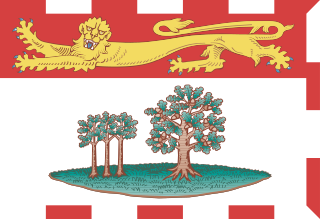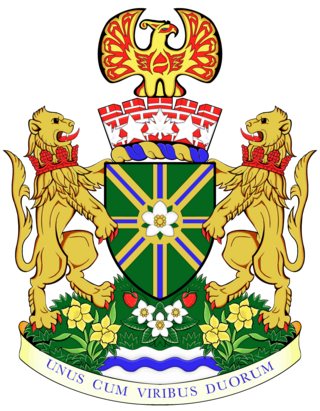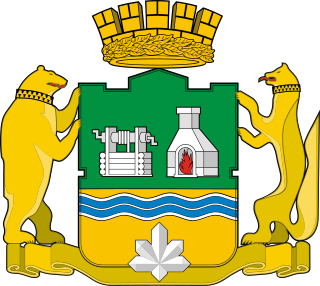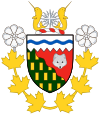
The flag of Newfoundland and Labrador was introduced in 1980 and was designed by Newfoundland artist Christopher Pratt. The flag design was approved by the House of Assembly of the province of Newfoundland, Canada, on May 28, 1980. It was flown for the first time on Discovery Day, June 24, 1980. The name of the province was changed to Newfoundland and Labrador by an amendment to the constitution of Canada in December 2001 at the request of the provincial legislature.

The coat of arms of Canada, also known as the Royal Coat of Arms of Canada or, formally, as the Arms of His Majesty The King in Right of Canada, is the arms of dominion of the Canadian monarch and, thus, also the official coat of arms of Canada. In use since 1921, it is closely modelled after the royal coat of arms of the United Kingdom, with French and distinctive Canadian elements replacing or added to those derived from the British version.

The coat of arms of Prince Edward Island, officially the King's Arms in Right of Prince Edward Island, are the coat of arms of Prince Edward Island, being the arms of King Charles III in right of the province. They were created when the shield and motto in the achievement were granted in 1905 by royal warrant from King Edward VII. The latest iteration was given by the Canadian Heraldic Authority in 2002.

The coat of arms of Saskatchewan, officially known as His Majesty's Arms in right of Saskatchewan, is the heraldic symbol representing the Canadian province of Saskatchewan.

The coat of arms of Nunavut was granted by a warrant of Roméo LeBlanc, Governor General of Canada, dated 31 March 1999, one day before the territory of Nunavut, Canada, was created. The same document specified the flag of Nunavut.

The coat of arms of Nova Scotia is the heraldic symbol representing the Canadian province of Nova Scotia. It is the oldest provincial achievement of arms in Canada, and the oldest British coat of arms in use outside Great Britain. It is blazoned as follows: Argent, a saltire azure charged with an escutcheon of the Royal Arms of Scotland.

The coat of arms of British Columbia is the heraldic symbol representing the Canadian province of British Columbia. The arms contains symbols reflecting British Columbia's British heritage along with local symbols. At the upper part of the shield is the Union Jack, representing the United Kingdom. The lower portion of the shield features a golden sun setting into the ocean, representing the province's location on the Pacific.

The coat of arms of Manitoba is the heraldic symbol representing the Canadian province of Manitoba. The arms contains symbols reflecting Manitoba's British heritage along with local symbols. At the upper part of the shield is the red cross of St. George, representing England. On the left, the unicorn represents Scotland. The lower portion of the shield features a bison standing atop a rock on a green background, a symbol of First Nations peoples of the area who derived food and clothing from the animal.

The coat of arms of Ontario is the armorial emblem representing the Canadian province of Ontario. The arms contain symbols reflecting Ontario's British heritage, along with local symbols. At the upper part of the shield is the red cross of St. George, representing England. The lower portion of the shield features three golden maple leaves on a green background.

The flag of Prince Edward Island consists of a golden lion passant on a red field in the upper portion and a white field charged with three oak saplings and a large oak tree on a green island in the bottom portion. This is bordered on three edges other than the hoist by a fimbriation of alternating red and white rectangles. Adopted in 1964 in the run-up to the Canadian Centennial, it has been the flag of the province since March 24 of that year. It is a banner of arms modelled after the province's coat of arms. When flown with the flags of other Canadian provinces and the national flag, it is eighth in the order of precedence.

The national emblem of Cape Verde contains a circle within which is written the name of the nation in Portuguese. Within the circle are a torch and triangle, symbols of freedom and national unity. At the top of the shield is a plumbob, a symbol of righteousness; three chain links are at the bottom. This emblem replaces the earlier variant with the seashell that had been in use since independence. The current emblem was adopted in 1999.

The coat of arms of Bosnia and Herzegovina was adopted in 1998, replacing the previous design that had been in use since 1992 when Bosnia and Herzegovina gained independence. It follows the design of the national flag. The three-pointed shield is used to symbolize the three major ethnic groups of Bosnia, as well as allude to the shape of the country.

The official flag of Nunavut was proclaimed on 1 April 1999, along with the territory of Nunavut in Canada. It features a red inuksuk—a traditional Inuit land marker—and a blue star, which represents the Niqirtsuituq, the North Star, and the leadership of elders in the community. The colours blue and gold represent the riches of the land, sea and sky. It was adopted following a process where input was sought from local communities and submissions were solicited from the Canadian public.

The coat of arms of Alberta, the heraldic symbol representing the Canadian province of Alberta, contains symbols reflecting Alberta's English heritage along with local symbols. The upper part of the shield features the red cross of Saint George. The lower portion of the shield depicts the Rocky Mountains, grass prairies, and wheat fields – representing Alberta's landscape.

The flag of the Northwest Territories, is the subnational flag of the Northwest Territories of Canada. It was adopted in 1969 by the Legislative Assembly of the Northwest Territories.

The flag of Yukon is a green, white, and blue tricolour with the coat of arms of Yukon at the centre above a wreath of fireweed, the territorial flower. An official flag for Yukon was created during the 1960s, a decade in which the national flag of Canada was chosen as well as several other provincial flags were created. The flag of Yukon was officially selected from a territory-wide design competition in 1967, with the winning design adopted on March 1, 1968.

Regional tartans of Canada are represented by all Canada's provinces and territories having a regional tartan, as do many other regional divisions in Canada. Tartans were first brought to Canada by Scottish settlers; the first province to adopt one officially was Nova Scotia in 1956, and the most recent province was Ontario, in 2000. Except for the tartan of Quebec, all of the provincial and territorial tartans are officially recognized and registered in the books of the Court of the Lord Lyon, King of Arms of Scotland.

The first coat of arms of Montreal was designed by Jacques Viger, the first mayor of Montreal, and adopted in 1833 by the city councillors. Modifications were made some one hundred five years later and adopted on 21 March 1938, and again on 13 September 2017, resulting in the version currently in use. The coat of arms was the only city emblem representing Montreal until 1981, when a stylized logo was developed for common daily use, reserving the coat of arms for ceremonial occasions.

The coat of arms of Abbotsford is the heraldic symbol representing the city of Abbotsford. The arms was granted by the Canadian Heraldic Authority on 25 October 1995. The grant included the full coat of arms as well as a flag and a badge, both derived from the arms.

The coat of arms of Yekaterinburg is the official municipal coat of arms of Yekaterinburg, Russia. The current symbol was adopted on 23 May 2008 and consists of a French shield divided horizontally into two fields, with a white mine shaft and a white furnace within the top field, which is green, and a blue wavy bend within the bottom field, which is gold. A gold bear and gold sable are located to the left and right of the shield, respectively. A gold crown with a gold laurel wreath is located above the shield and a gold ribbon is located below the shield. A grey druse is located at the bottom center of the shield.






















